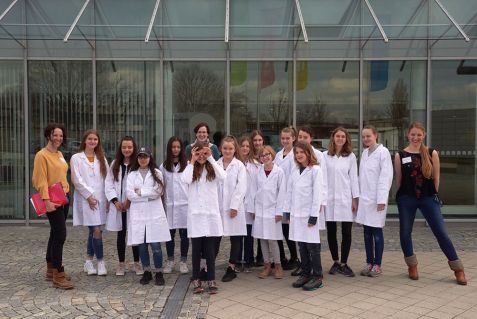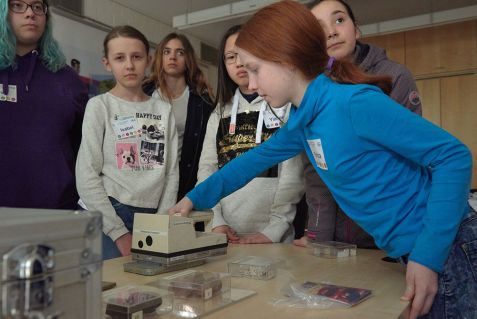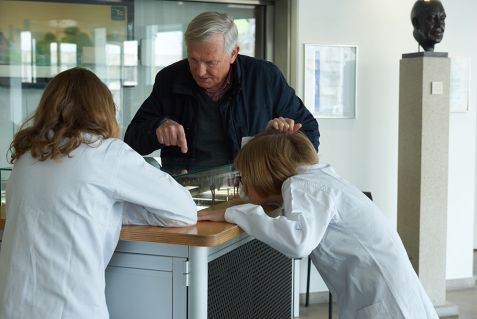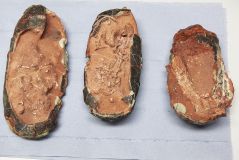MLZ is a cooperation between:
 > Technische Universität München
> Technische Universität München > Helmholtz-Zentrum Hereon
> Helmholtz-Zentrum Hereon
 > Forschungszentrum Jülich
> Forschungszentrum Jülich
MLZ is a member of:
 > LENS
> LENS > ERF-AISBL
> ERF-AISBL
MLZ on social media:

MLZ (eng)
Lichtenbergstr.1
85748 Garching
28.03.2019
A future day for girls – become a scientist!
On 28th March, The Research Neutron Source (FRM II) opened its doors for national Girls’ Day. More than 30 interested girls were introduced to the job of a “scientist” and learned about neutrons and what you can do with them. Johanna Jochum, scientist at the RESEDA instrument, talks about a typical working day at the neutron source.
More than 400 people are supposed to work at the FRM II, but where are they all? But before we go in search of the scientists, let us talk about radioactivity. What is radioactivity? Can you see radiation and is it dangerous? We have brought an experimental case with us full of different materials ready to be examined for radiation. Using a Contamat, a measuring device for detecting and evaluating surface contamination by alpha, beta and gamma radiation, the activity (decay of atoms per second) in the material can be detected.
There are different samples to choose from, e.g. uranium-containing tiles, granite from the Fichtelgebirge, watches with 147Pm luminous dials as well as garden fertilizer, salt (potassium chloride) and potash which is used for baking gingerbread – these are all full of radiation from natural sources. Nevertheless, what does radiation actually look like? Shortly before the tour of the reactor starts, we make a stop at the cloud chamber. Christoph Morkel (TUM) joins us spontaneously and explains to the girls how such a cloud chamber works: it helps us see thick short alpha particles and even long thin beta particles of natural radiation with the naked eye.
Time is short; we start the special tour for our young scientists. The first station is the visitor window, where the girls can have a look into the reactor pool. We continue to the second station, which is located in the basement of the reactor building – the control center. The reactor monitoring runs in shift operation and is continuously (24/7) manned by 2-3 reactor operators, depending on whether the FRM II is in operation or not. So many display devices and numerous important looking controllers and buttons – but what are they all for? The shift supervisor explains some of the controls and their functions, then he talks about his typical working day and the special training to become a reactor controller. The last station of the tour is in the Neutron guide hall. From the gallery you can see the instruments quite well. What do the scientists actually investigate with neutrons? The eyes of the girls sparkle as we explain the experiment with the 70 million year old Dino eggs.
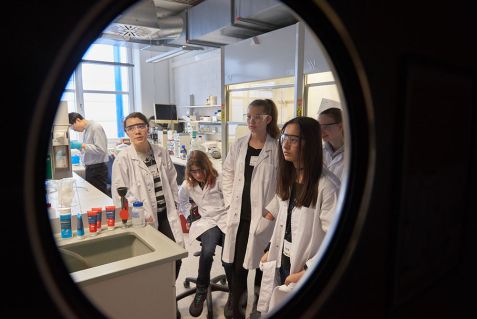
Visit to the biology and chemistry laboratory at the Heinz Maier-Leibnitz Centre (MLZ). © W. Schürmann / TUM
Once again, the question of employees arises – so many instruments but where are the scientists? We explain that FRM II is currently on a maintenance break, i.e. there are currently no neutrons and therefore no scientists working on the instruments. So let us go and find the scientists! On our way to the laboratories, we occasionally meet employees in the corridors, offices and also in the laboratories. In order to be allowed to enter them, everyone must wear protective goggles in addition to their lab coats. Our two laboratory staff members Tabea Bartelt and Livia Balacescu (Biology and Chemistry) answer an infinite number of questions, such as “What kind of training do you have to have in order to work in the laboratory? What does a normal working day look like for you? Can you manage your own time? What are the tasks of a CTA? Who is liable if something happens in the laboratory or something is damaged? Have you ever hurt yourself? Do you always have to document everything you have done? Do you have to speak English? Do you have to know the periodic table of elements by heart for your profession?”
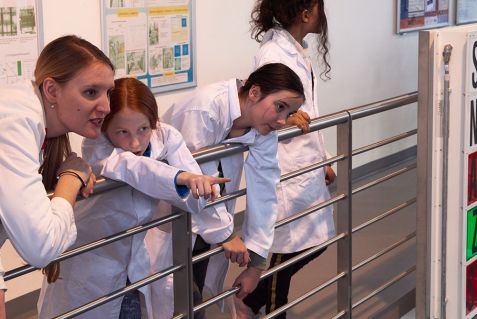
Dr. Johanna Jochum (TUM) explains how the neutrons get from the reactor to the instruments. © W. Schürmann / TUM
During the question-and-answer session, the girls perform some typical laboratory activities: measuring the pH value of various liquids, observing crystal growth under the microscope, producing orange extract (with the rotary evaporator), weighing various substances with a special scale and, to top it all off, demonstrating the “black worm” experiment. Sugar is mixed with sulphuric acid and what happens next can be discovered at the next Girls’Day on 26 March 2020!
MLZ-Team
Johanna Jochum (scientist), Tobias Schrader (scientist / laboratory manager), Tabea Bartel (chemical-technical assistant (CTA)), Livia Balacescu (PhD student), Anke Görg (Science Communications Manager) and Katharina Bock (physics student), Christoph Morkel (TUM)
Related News
-
14.03.2018
Three dinosaur eggs at the MLZ
MLZ is a cooperation between:
 > Technische Universität München
> Technische Universität München > Helmholtz-Zentrum Hereon
> Helmholtz-Zentrum Hereon
 > Forschungszentrum Jülich
> Forschungszentrum Jülich
MLZ is a member of:
 > LENS
> LENS > ERF-AISBL
> ERF-AISBL
MLZ on social media:



